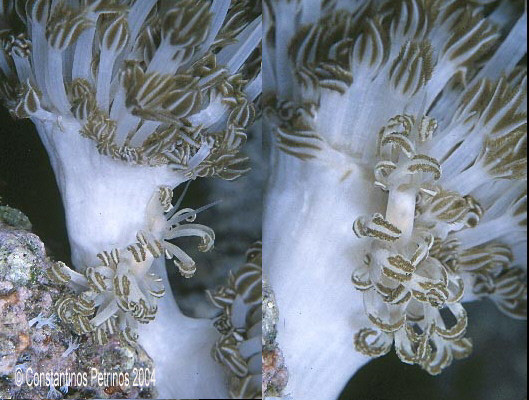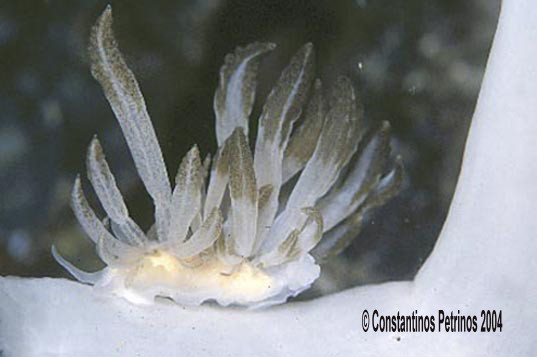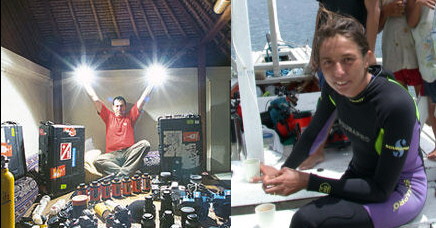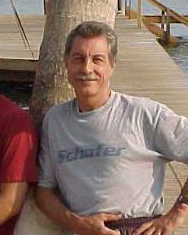 |
Phyllodesmium jakobsenae
Taken at Anilao, Batangas, PhilippinesPhoto courtesy of Constantinos Petrinos and Carine Schrurs
Phyllodesmium jakobsenae
One of at least two undescribed species of Phyllodesmium, which are cryptic on colonies of the soft coral, Xenia, has recently been given a name. This incredible species is another example of a "solor-powered" nudibranch, sequestering symbiotic dinoflagelllates called zooxanthellae in the body tissue.

Phyllodesmium jakobsenae differs from the other " Xenia Mimic"; seen here on Mikeís site and on Bill Rudmanís Forum as Phyllodesmium sp. 11, in having flattened, slightly coiled cerata with brownish pigment along the edges, near the tip. The other Xenia mimic, has rounded, bulbous cerata with several longitudinal line of brown pigmentation, looking identical to the closed polyp of Xenia. Both have been overlooked for years due to their ability to hide, unnoticedamong the corals polyps. |
Con and Carineís photo here clearly shows the brownish colored zooxanthellae housed in a network of digestive system branches. The smaller, lateral cerata have a cnidsac at their tip full of nematocysts, which are reported not present in the larger, medial cerata.
Similar in a way to the sacoglossid sea slugs, the microscopic single-celled plants or zooxanthellae are aggregated into bundles on the upper surface of the cerata where they are most likely to receive the greatest exposure to light. The zooxanthellae are well adapted to living within the tissues of animals, having come directly from the tissues of the coral the nudibranch has fed upon. It is important to realize the environmental value of zooxanthellae, as without them, the tiny coral polyps would not be able to assist in the production the calcium carbonate skeleton of the coral structures. This microscopic creature is truly the provider of the cement that creates the largest animal made structures on earth; our great coral reefs.
Studies on the very beautiful aeolid Pteraeolidia ianthina have shown that zooxanthellae within this species body, breed very rapidly, and at the same time produce nutrients, far in excess of their own requirements. Like the other species, Pteraeolidia spends most of its time on the upper surfaces of reef substrates allowing sunlight to reach the photosynthetic tissue within its cerata, optimizing the production of sugars and other carbohydrates. Some biologists like to say that the nudibranch has become an effective and efficient chloroplast or zooxanthellae "farmer", because the sea slugs have modified their anatomy to better enable them to keep the plant tissues in an optimum environment for growth and photosynthesis. These species have developed finely branched digestive systems, which lead into the skin layers of their flattened, transparent cerata. Each of these modifications enhances the ability of the animal to farm a good crop. It is in these systems, or pastures that the plant tissue is sown. Phyllodesmium jakobsenae is one of the species that has made major anatomical changes, which can be correlated with the varying ability between species to grow zooxanthellae in their bodies. An interesting behavior seen in this species is that during periods of greatest illumination, the animal spreads it cerata out flat, another mechanism optimizing farming itís symbionts.
Phyllodesmium jakobsenae is named to recognize, Mrs. Wera Jakobsen, who the authors acknowledge is a passionate diver, and who has supported alpha taxonomy research on sea slug through a generous donation to the BIOPAT (Patrons for Biodiversity).
Mike and I would like to thank Nishina Masayoshi for bringing this new name to our attention
Reference:
Burghardt, I & H. Wagele. 2004. A new solar powered species of the genus
Phyllodesmium Ehrenberg, 1831 (Mollusca:Nudibranchia:Aeolidoidea) from
Indonesia with analysis of its photosynthetic activity and notes on biology.
Zootaxa 596:1-18.
Danville, Calif
Dec. 2004
Constantinos Petrinos and Carine Schrurs

|
Constantinos's photographs have won awards at many competitions, including the BBC Wildlife Photographer of the Year. His articles and photos have appeared in various magazines, such as BBC Wildlife, Tauchen, Der Spiegel, Duiken, Dive, Oceans Illustrated, Skin Diver, Scuba Diver Australasia and the Greek editions of National Geographic and National Geographic Traveller. He is the photographer on location for the Hellenic Institute of Marine Archaeology, which conducts underwater excavations in conjunction with the Greek Ministry of Culture. Constantinos is the underwater photography expert for the Nikon Owners Club International. Throughout the year, Constantinos conducts slide shows in Greek schools, to promote marine awareness. He is a Fellow of the Royal Photographic Society.
Constantinos prefers to stay on location for a minimum of two months when working on major projects. He believes that you need to spend many hours underwater to familiarise yourself with the particular habitat and the species present in order to be able to capture behavioural scenes on film. For his book, Realm of the Pygmy Seahorse , he spent five months in Sulawesi and took 25,000 slides.
Send Contantinos mail at petrinos@otenet.gr
or visit his Web Site .
Taxonomic information courtesy of:

David W. Behrens
Author:
Pacific Coast Nudibranchs
Send Dave mail at dave@seachallengers.com
|
